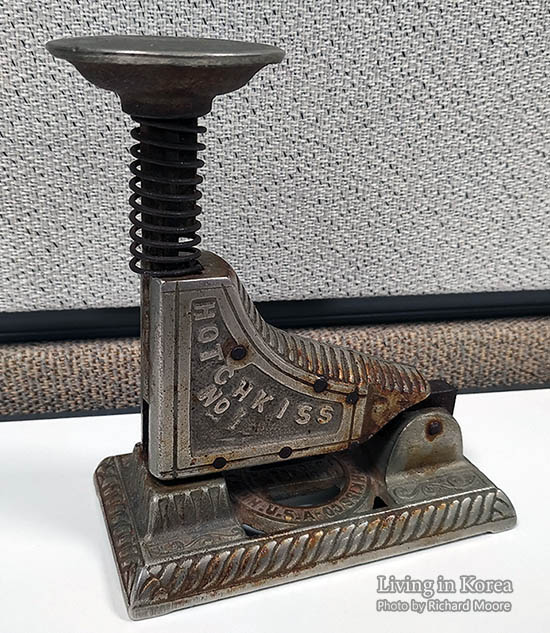Note: As the payment of taxes and fees significantly overlaps the contents related to paying rent and utilities, the contents are largely copy-pasted.
The giro system is common in Korea for payment of bills, taxes, various fees, and utilities. At the bottom of certain bills you'll notice 지로 which is Romanized at jiro but comes from the term giro. If you are unfamiliar with giro, check out the related Wikipedia page.

In order to pay utility bills, people are given a list of banks in which they can wire money to. This is great as chances are you have an account with one of these banks and can therefore avoid service fees. In the same image below, the list of banks and virtual accounts you could send payment into are written in the red box. It is typically for the names of the banks to only be written in Korean on your bill. The number of available accounts will vary anywhere from around four to perhaps ten. In the example below, the last account listed on the bottom right is the post office, which is written as 우체국 (郵遞局, ucheguk).

But to make, say eight accounts that you can pay into, as is shown above, the utility companies will make a significantly large number of virtual accounts to receive payment as they would need to make eight accounts for every customer they have nationwide. Sometimes the virtual account is made just for you, so it is very clear to see who paid, and sometimes a number of residents pay into the same virtual account. As everyone has a bill with a different payment amount, it is easy to match values and confirm payments. Names are also attached to the bills and to the sending bank accounts so they can also use this method to match who paid what bill.
When you move into your residence, your name should be on the bill from the next payment cycle. Sometimes the name doesn’t change, and if it hasn’t changed after a few months, it isn’t going to change. If it isn’t your name, that’s okay. As long as your name is on the housing paperwork, and you are paying your bills on time, you should be okay but you might have someone contact you to confirm who is paying whose bill if the name on the bill and the name on the sending bank account don't match.
When you open a bank account, your name will be on that account and connected to that account’s transactions. When you wire money through your bank, the name on the sending bank account will be attached to the wire transfer but can be substituted for a memo if you wish to manually add that. If the name on the bill and the name on the bank account match, everything is good. However, if Richard Moore is new to Korea and is still figuring out how to wire money, he may ask a friend or co-worker for help. This means Richard then asks Hong Gil-dong to wire money covering Richard’s utility payment and Richard pays Gil-dong in cash. Payment is paid and bills are finished but Mr. Hong’s name will be attached and seen by the receiving group, not Richard’s. Alternatively, if Miss Shin used to live there and the name on the bill didn’t change to Richard, the names won’t match. On the rare occasion that your payment and someone else’s payment are for the exact same amount of won, the receiving office will be unsure who paid as the names don’t line up. In this case, the group might need to call Richard to see if he paid.
If you live in a dormitory, your utilities should be included in your rent. Congratulations, you are done as soon as you pay rent. If you live in an apartment, you’ll get a very long and detailed bill which is so wide it must first be folded in half vertically before being folded horizontally to fit into an envelope. The size of the document is so large as the rear side details where payments go for transparency reasons. If you live somewhere else, your bill will be more simple with a basic front and back single piece of paper. Let’s look at this simpler bill format first. We'll show the whole bill and then break it down into sections. This first example is of a gas bill. If you want to see the images and words more clearly, click the picture to see a larger version of the image.
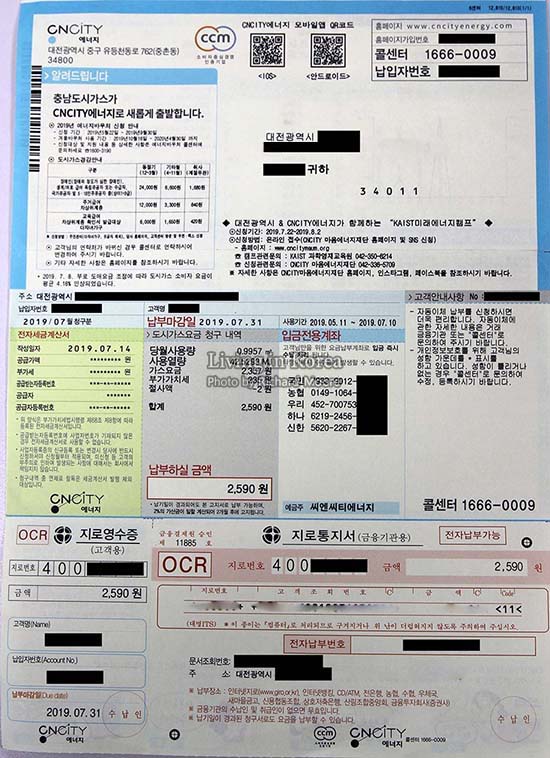
Here is the top section of a gas bill. Top left is sender, top right is their contact information, top middle gives download links for smartphone applications. And the last bit of critical information is the address they are sending the bill to. In this example, the address is spread over two lines, an empty line, and then the tenant’s name. Even if a bill arrives in your mailbox, do check to make sure you got your bill and not your neighbor’s by mistake. If you want to see the images and words more clearly, click the picture to see a larger version of the image.

Here is the middle section of a gas bill. The first section to the left, in the very yellow box, shows what the bill was for this month one year ago. As the tenant lived here for less than a year, the price for the previous year is missing. The next box, which is a light yellow color, mentions the quantity of gas used, the joules of power, the price for the gas you used, a tax, a discount, and finally the total. The third box is a list of bank accounts which you can pay into to pay your gas bill. If you want to see the images and words more clearly, click the picture to see a larger version of the image.
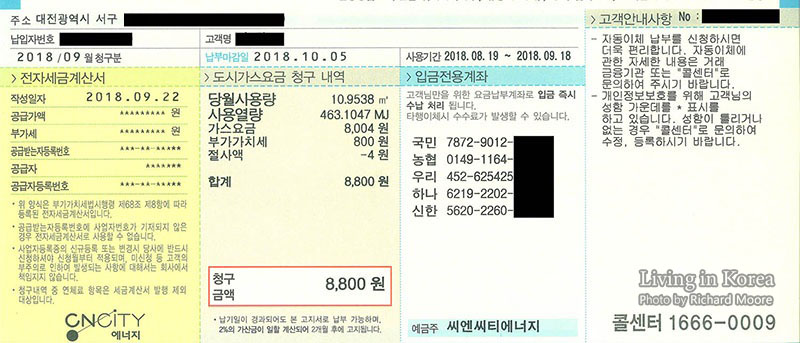
Here is the bottom section of a gas bill. The left box shows the giro number, the fee, name of tenant, account number, and due date. The wide box to the right gives a more specific customer number and your address. The red dotted circles are for bank tellers to stamp if you pay in person at a bank. If you want to see the images and words more clearly, click the picture to see a larger version of the image.
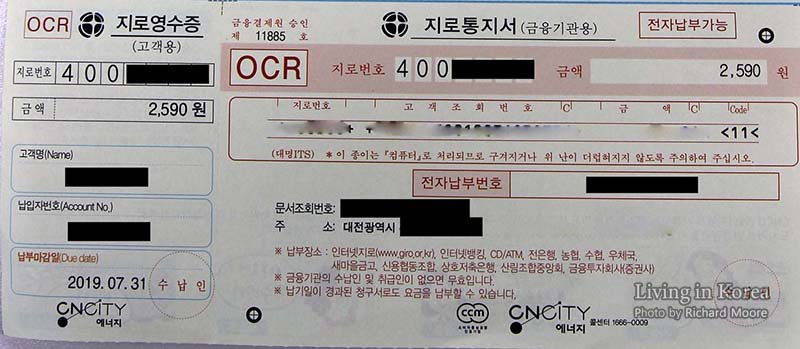
In case you were curious, here is the rear side of a gas bill. There are not as much contents on the rear side so we cropped off the empty space at the bottom half. The larger middle section with yellow header shows a graph with the joules on the left and the price the tenant paid on the right. The fluctuate of the graph is a good indication of how much the floor heater was used during colder winter months. To the right of the graph is a chart showing the last 13 months, the joules of power used, and the price charged to the tenant. The bottom section with the blue header is a breakdown of why they are charging what they are charging. If you want to see the images and words more clearly, click the picture to see a larger version of the image.

Now let’s look at the much larger and longer bills that are common in apartments. Just like the previous utility type, we’ll show the entire bill at once and then break it down into small pieces. If you want to see the images and words more clearly, click the picture to see a larger version of the image.
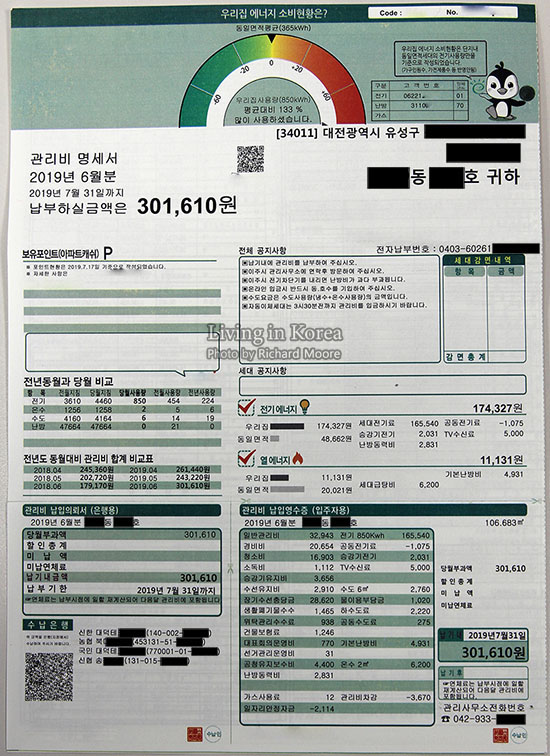
This is the top section of an apartment combined utility bill. Your full address and name will be on the right. Your building number will appear before 동 and your apartment number will appear before 호. For more information on the dual address systems in Korea, click here. The green to red half circle shows what is the average energy usage, stated as 365kWh, and your usage, in this case it is 850kWh and so the corresponding arrow is as far into the red as it can go. The high usage came from multiple desktops and a laptop contributing to BOINC while the air conditioner was running during a summer month. If you want to see the images and words more clearly, click the picture to see a larger version of the image.
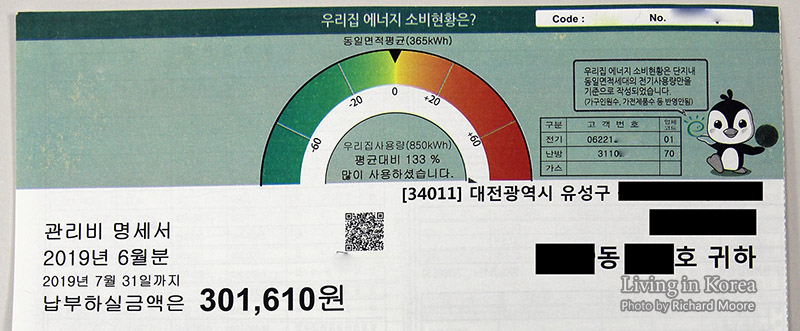
This is the middle section of the bill. On the left side are two sets of graphs. The first is a breakdown of charges for this month last year compared to this month. The bottom graph shows the total price paid for this time last year over the last three months and then the price paid for this year during the same months.
The right side also has two sections; electricity usage and breakdown and energy, specifically hot water for sinks, showers, and the floor heater system. The first line of the electricity section shows electricity usage and cost thereof for your home and the average in the area. To the right of it is a breakdown with the first time showing your usage in your home. The items are electrity usage for the apartment complex but not inside your residence. This includes elevator, heating of some sort, a discount, and then a fixed price for TV.
The right side bottom is similar. In this bill the tenant used 6,200 won worth of heated water and a basic charge of 4,931 won is added to it. If you want to see the images and words more clearly, click the picture to see a larger version of the image.

This is the bottom section. The left is marked with 은행용 (銀行用, eunhaengyong) in parenthesis to indicate it is for the bank. The total price is displayed and the due date is given, in this case July 31. The right side has the words 입주자용 (入住者用, ipjujayong) in parenthesis to indicate it is for the tenant. The address is given and the size of the apartment is shown on the far far right, in this case 106.683 meters squared. The chart is a breakdown of the bill, including general expense for management, cleaning fee, disinfections, repairs, food trash disposal, etc. If you want to see the images and words more clearly, click the picture to see a larger version of the image.
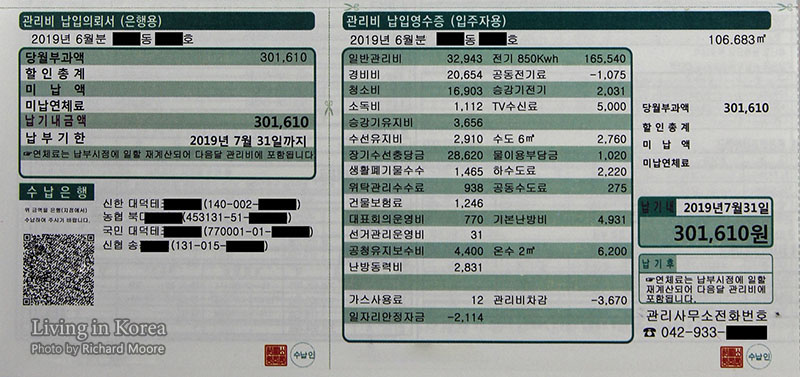
If you unfold the apartment combined utility bill, this is what you’ll see. A super detailed list of why they charge for what they charge and where the money is going. If you want to see the images and words more clearly, click the picture to see a larger version of the image but there is so much content that even the large size of this image is a bit blurry.
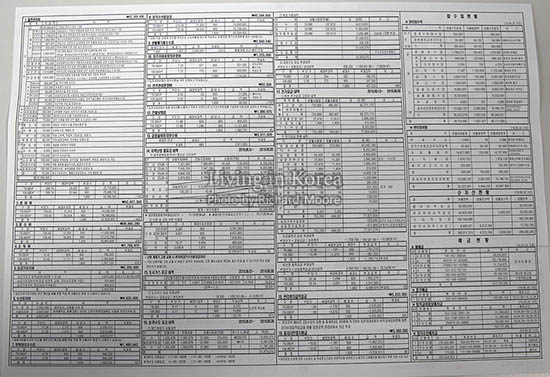
You can pay utility bills by sending money to one of the accounts listed on your bill. This can be done online, via a smartphone app, at an ATM , or via a bill payment machine inside a bank branch. Bank tellers used to help people with paying utility bills and would physically stamp the paperwork when completed to prove the bill was successfully paid. These days, tellers will bring you to the machine and try to teach you how to use it to pay your bills. When you enter the bank and are clearly holding the utility bill paperwork, the security guard will try and intercept you. They do this so you can avoid waiting in the line and the guard can instead show people to the special bill payment machine and will help with what buttons need pressing if you need the assistance.
These bill paying machines and the cash dispensing ATMs sometimes get confused by calling the former an ATM as well. The bill payment kind are called 공과금 수납기 (公課金 收納機, gonggwageum sunapgi) which translates to “utility bills”. The cash dispensing kind will be in the entrance to the bank and are accessible when the bank is closed. The bill payment kind are inside the bank lobby, usually off to the side, and there is only one per branch.
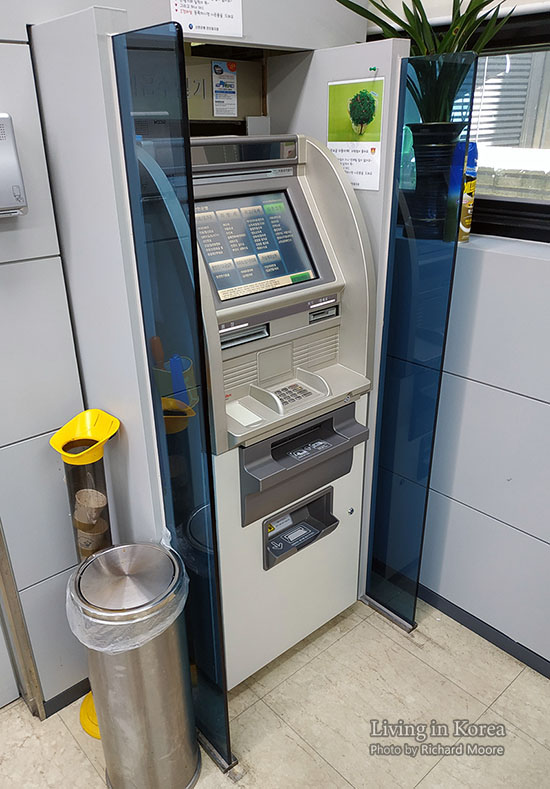
To avoid confusion, the unit in the image below has a sign above it declaring it to be for bill payment only. Additional signs say this is not for student tuition payment, and all electronically sent bills cannot be done at this machine. You can voluntarily change from paper-based bills to electronically sent ones and will receive a small cost reduction accordingly. If your bill comes in paper format, it can be used in this machine. In addition to utility bills, a number of other payments can be sent, including vehicle taxes and fines. Also notice the stapler on the top right of the machine. It is standard for a stapler to be on or nearby these machines so people can staple the receipt to the utility bills; both for their own paperwork and also to prove they paid if there is ever an issue.
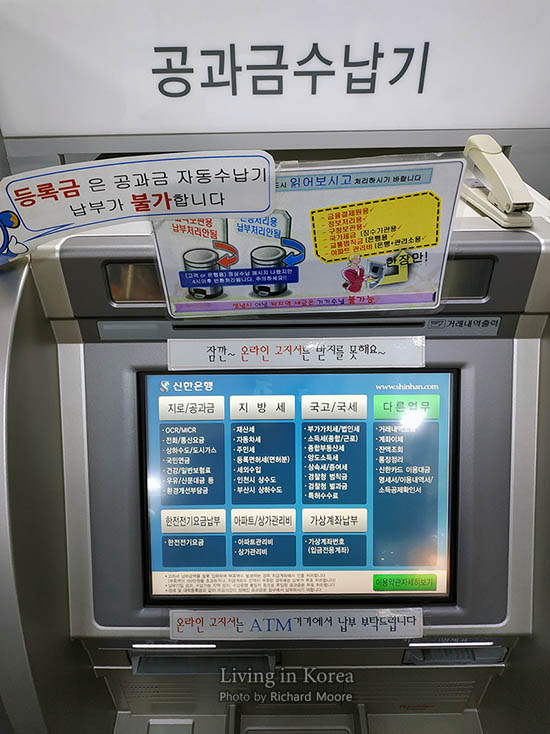
If you don’t see a stapler you can ask for one by saying the word for stapler; 호치키스 (hochikiseu). If you lived in Japan, you’ll be used to this term as the Japanese language uses ステープラー. The first mass produced staplers were from the Hotchkiss company in 1895 and were a patented design. When these products came over to East Asia they become known by the company name; Hotchkiss. Here is one from the first year of production.
